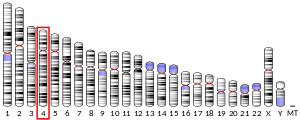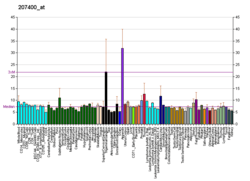Neuropeptide Y receptor Y5
Neuropeptide Y receptor type 5 is a protein that in humans is encoded by the NPY5R gene.[5][6][7]
Selective ligands
Agonists
- Neuropeptide Y (endogenous agonist, non subtype selective)
- BWX-46 (selective NPY5 agonist, CAS# 172997-92-1)
- Peptide YY
Antagonists
- CGP-71683 (CAS# 192322-50-2)
- FMS-586[8]
- L-152,804 (CAS# 6508-43-6)
- Lu AA-33810[9]
- MK-0557[10]
- NTNCB (CAS# 486453-65-0)[11]
- Velneperit (S-2367)
gollark: Encoding is proceeding at just 0.5x speed.
gollark: There we go, 10 FPS, good enough*.
gollark: I am adjusting the encoder settings. FEAR mild quality degradation.
gollark: Okay, Macronous encoding apioids online.
gollark: Sorry, making the encoder go fast is hard.
See also
References
- GRCh38: Ensembl release 89: ENSG00000164129 - Ensembl, May 2017
- GRCm38: Ensembl release 89: ENSMUSG00000044014 - Ensembl, May 2017
- "Human PubMed Reference:". National Center for Biotechnology Information, U.S. National Library of Medicine.
- "Mouse PubMed Reference:". National Center for Biotechnology Information, U.S. National Library of Medicine.
- Gerald C, Walker MW, Criscione L, Gustafson EL, Batzl-Hartmann C, Smith KE, Vaysse P, Durkin MM, Laz TM, Linemeyer DL, Schaffhauser AO, Whitebread S, Hofbauer KG, Taber RI, Branchek TA, Weinshank RL (Jul 1996). "A receptor subtype involved in neuropeptide-Y-induced food intake". Nature. 382 (6587): 168–71. doi:10.1038/382168a0. PMID 8700207.
- Lutz CM, Richards JE, Scott KL, Sinha S, Yang-Feng TL, Frankel WN, Thompson DA (Dec 1997). "Neuropeptide Y receptor genes mapped in human and mouse: receptors with high affinity for pancreatic polypeptide are not clustered with receptors specific for neuropeptide Y and peptide YY". Genomics. 46 (2): 287–90. doi:10.1006/geno.1997.5024. PMID 9417917.
- "Entrez Gene: NPY5R neuropeptide Y receptor Y5".
- Kakui N, Tanaka J, Tabata Y, Asai K, Masuda N, Miyara T, Nakatani Y, Ohsawa F, Nishikawa N, Sugai M, Suzuki M, Aoki K, Kitaguchi H (May 2006). "Pharmacological characterization and feeding-suppressive property of FMS586 [3-(5,6,7,8-tetrahydro-9-isopropyl-carbazol-3-yl)-1-methyl-1-(2-pyridin-4-yl-ethyl)-urea hydrochloride], a novel, selective, and orally active antagonist for neuropeptide Y Y5 receptor". The Journal of Pharmacology and Experimental Therapeutics. 317 (2): 562–70. doi:10.1124/jpet.105.099705. PMID 16436501.
- Walker MW, Wolinsky TD, Jubian V, Chandrasena G, Zhong H, Huang X, Miller S, Hegde LG, Marsteller DA, Marzabadi MR, Papp M, Overstreet DH, Gerald CP, Craig DA (Mar 2009). "The novel neuropeptide Y Y5 receptor antagonist Lu AA33810 [N-[[trans-4-[(4,5-dihydro[1]benzothiepino[5,4-d]thiazol-2-yl)amino]cyclohexyl]methyl]-methanesulfonamide] exerts anxiolytic- and antidepressant-like effects in rat models of stress sensitivity". The Journal of Pharmacology and Experimental Therapeutics. 328 (3): 900–11. doi:10.1124/jpet.108.144634. PMID 19098165.
- MacNeil DJ (2007). "NPY Y1 and Y5 receptor selective antagonists as anti-obesity drugs". Current Topics in Medicinal Chemistry. 7 (17): 1721–33. doi:10.2174/156802607782341028. PMID 17979781. Archived from the original on 2013-01-12. Retrieved 2020-04-16.
- Islam I, Dhanoa D, Finn J, Du P, Walker MW, Salon JA, Zhang J, Gluchowski C (Jul 2002). "Discovery of potent and selective small molecule NPY Y5 receptor antagonists". Bioorganic & Medicinal Chemistry Letters. 12 (13): 1767–9. doi:10.1016/S0960-894X(02)00287-1. PMID 12067557.
Further reading
- Parker E, Van Heek M, Stamford A (Apr 2002). "Neuropeptide Y receptors as targets for anti-obesity drug development: perspective and current status". European Journal of Pharmacology. 440 (2–3): 173–87. doi:10.1016/S0014-2999(02)01427-9. PMID 12007534.
- Hu Y, Bloomquist BT, Cornfield LJ, DeCarr LB, Flores-Riveros JR, Friedman L, Jiang P, Lewis-Higgins L, Sadlowski Y, Schaefer J, Velazquez N, McCaleb ML (Oct 1996). "Identification of a novel hypothalamic neuropeptide Y receptor associated with feeding behavior". The Journal of Biological Chemistry. 271 (42): 26315–9. doi:10.1074/jbc.271.42.26315. PMID 8824284.
- Herzog H, Darby K, Ball H, Hort Y, Beck-Sickinger A, Shine J (May 1997). "Overlapping gene structure of the human neuropeptide Y receptor subtypes Y1 and Y5 suggests coordinate transcriptional regulation". Genomics. 41 (3): 315–9. doi:10.1006/geno.1997.4684. PMID 9169127.
- Nichol KA, Morey A, Couzens MH, Shine J, Herzog H, Cunningham AM (Dec 1999). "Conservation of expression of neuropeptide Y5 receptor between human and rat hypothalamus and limbic regions suggests an integral role in central neuroendocrine control". The Journal of Neuroscience. 19 (23): 10295–304. doi:10.1523/JNEUROSCI.19-23-10295.1999. PMID 10575027.
- Rodriguez M, Audinot V, Dromaint S, Macia C, Lamamy V, Beauverger P, Rique H, Imbert J, Nicolas JP, Boutin JA, Galizzi JP (Feb 2003). "Molecular identification of the long isoform of the human neuropeptide Y Y5 receptor and pharmacological comparison with the short Y5 receptor isoform". The Biochemical Journal. 369 (Pt 3): 667–73. doi:10.1042/BJ20020739. PMC 1223119. PMID 12398768.
- Berglund MM, Schober DA, Statnick MA, McDonald PH, Gehlert DR (Jul 2003). "The use of bioluminescence resonance energy transfer 2 to study neuropeptide Y receptor agonist-induced beta-arrestin 2 interaction". The Journal of Pharmacology and Experimental Therapeutics. 306 (1): 147–56. doi:10.1124/jpet.103.051227. PMID 12665544.
- Beauverger P, Rodriguez M, Nicolas JP, Audinot V, Lamamy V, Dromaint S, Nagel N, Macia C, Léopold O, Galizzi JP, Caignard DH, Aldana I, Monge A, Chomarat P, Boutin JA (Apr 2005). "Functional characterization of human neuropeptide Y receptor subtype five specific antagonists using a luciferase reporter gene assay". Cellular Signalling. 17 (4): 489–96. doi:10.1016/j.cellsig.2004.09.006. PMID 15601626.
- Movafagh S, Hobson JP, Spiegel S, Kleinman HK, Zukowska Z (Sep 2006). "Neuropeptide Y induces migration, proliferation, and tube formation of endothelial cells bimodally via Y1, Y2, and Y5 receptors". FASEB Journal. 20 (11): 1924–6. doi:10.1096/fj.05-4770fje. PMID 16891622.
- Coletta DK, Schneider J, Stern MP, Blangero J, DeFronzo RA, Duggirala R, Jenkinson CP (Apr 2007). "Association of neuropeptide Y receptor Y5 polymorphisms with dyslipidemia in Mexican Americans". Obesity. 15 (4): 809–15. doi:10.1038/oby.2007.610. PMID 17426313.
External links
- "Neuropeptide Y Receptors: Y5". IUPHAR Database of Receptors and Ion Channels. International Union of Basic and Clinical Pharmacology.
This article is issued from Wikipedia. The text is licensed under Creative Commons - Attribution - Sharealike. Additional terms may apply for the media files.




